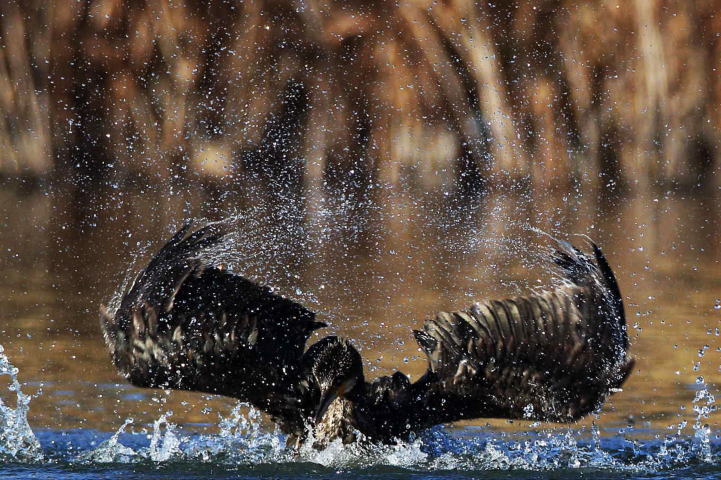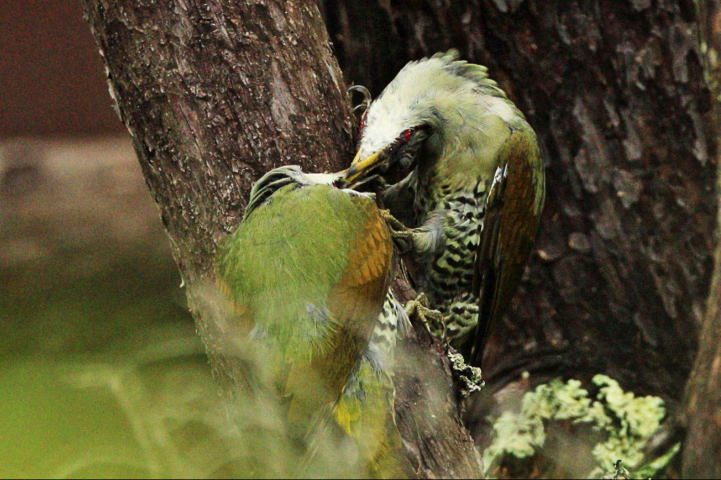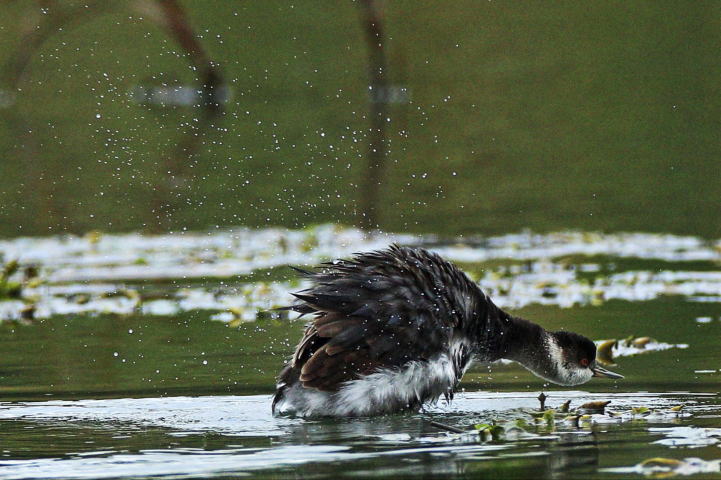








What are you doing? 70th
 The bathing of this species of bird is always exciting.
The bathing of this species of bird is always exciting.
Especially the view from the front S seat is worth seeing.
It seems to be whining, doesn't it? Even though It often dives, bathing must be exceptional.
What are you doing? 69th
 I wonder where it slept last night and how it slept.
I wonder where it slept last night and how it slept.
If it was a human, it would definitely get frostbite.
I'm sure it's muttering something like "Ah, I'm good I am a bird."
What are you doing? 68th
 I saw it in a stream a little into the valley from the village.
I saw it in a stream a little into the valley from the village.
It was preening on a rock in the stream.
At the end, it stretched out its wings and gave me a crackling wink.
(Note: The nictitating membrane of Brown Dipper is white. You can observe
it if Brown Dipper give you a wink! )
What are you doing? 67th
 The bird was hovering, looking for a space that might allow it to enter.
It was trying to perch on the electric wire, but there was so full that
it had a hard time breaking in.
Such a figure is like a ballet prima.
The bird was hovering, looking for a space that might allow it to enter.
It was trying to perch on the electric wire, but there was so full that
it had a hard time breaking in.
Such a figure is like a ballet prima.
What are you doing? 66th
 The bird came walking with a terrified look on its face.
"Will you pass by? Come on, please, please."
Be careful not to make eye contact.
The bird came walking with a terrified look on its face.
"Will you pass by? Come on, please, please."
Be careful not to make eye contact.
What are you doing? 65th
 The bird breed a lot in Azumino.
The bird breed a lot in Azumino.
Is it going to throw up a pellet for a second !? I expected it, but it
was a big yawn with
the whites of the eyes peeled (more precisely, the nictitating membrane was closed).
The gap with the composed face of everyday is funny.
What are you doing? 64th
 Two immature birds were chasing each other on the trunk of a tree, but eventually
Two immature birds were chasing each other on the trunk of a tree, but eventually
it developed into a fight (probably) by pinching with their beaks.
They seem to have fewer neck joints than owls, but more than humans.
That seems to have quite a lot!
What are you doing? 63th
 It's like watching a wet dog shakes body.
It's like watching a wet dog shakes body.
I sometimes see hawks fluttering while flying.
Both are shaking off something clinging to the body.
Who is saying that "I also want to shake off the entanglements of life..." ?
*No. 62 is omitted because it was an introduction to the illustrated book
of birds.
What are you doing? 61th

It is pecking at the petals of the magnolia .
The tongue can be seen between the beaks, and the tip of the tongue is
brush-like.
This is to make it easier to lick the nectar of the flowers. It's not that the tongue is rough.
Now, what other birds have tongues like this?
I got it! , That beautiful warbler color... I certainly agree.
So what about the tip of a hummingbird's tongue?
What are you doing? Back Number
What are you doing? 51th-60th
Brown-eared Bulbul
Black-throated loon
Herring Gull
Alpine Accentor
Japanese Sparrowhawk
Japanese Tit
Eastern Spot-billed Duck
Dusky Thrush
Northern Lapwing
Narcissus Flycatcher
What are you doing? 41th-50th
Blue-and-white Flycatcher
Black Kite Osprey
Japanese Paradise Flycatcher
Eurasian Skylark
Rock Ptarmigan
Eurasian Jay
Black-tailed Gull
Pacific Swift
Greater White-fronted Goose
Grey Wagtail
What are you doing? 31th-40th
Great Spotted Woodpecker
Japanese Pygmy Woodpecker
Northern Goshawk
Black-winged Stilt
Bar-tailed Godwit
Grey Plover
Whimbrel
Osprey
Little Ringed Plover
Long-tailed Tit
What are you doing? 21th-30th
Little Ringed Plover
Common Greenshank
Barn Swallow
Eurasian Coot
Azure-winged Magpie vs. Common Buzzard
Carrion Crow
Coal Tit
Bull-headed Shrike
Honey Buzzard
Japanese Green Woodpecker
What are you doing? 11th-20th
Common Moorhen
Little Ringed Plover
Tufted Duck
Brown-eared Bulbul
Water Rail and Eurasian Coot
Peregrine Falcon
Great Cormorant
Oriental Turtle Dove
Oriental Stork
Striated Heron
What are you doing? 1st - 10th Pale Thrush
Eastern Spot-billed Duck
Tree Sparrow
Great Crested Grebe
Grey Wagtail
Black Kite
Tufted Duck
Copper Phesant
Japanese Wagtai
Who is taking these wonderful photos?
Minoru Tadachi Don't worry be happy
He lives in the heart of Azumino field, works here, looks at birds, flowers
and a cloud everyday.
There are springs from Mt.Jonen and Chogatake, lush greenery, wasabi fields
and blue sky.
In such daily life, Tadachi-san talks to living things around him everyday.
"Good morning everyone! What are you doing?"
Wild birds and insects reply to him.
"Good morning Tadachi-san! What are you doing?"
In such way, the day begins and ends.
These are wonderful photos from such a country life.
Return to top of page










